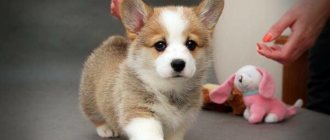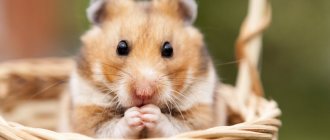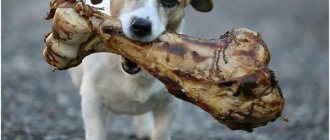Moving to a new home is a very important and exciting event in the life of a small four-legged animal. To minimize his stress, it is necessary to know at what age puppies are taken from their mother. Separation too early is detrimental not only to the psyche, but also to health.
There are also nuances regarding obtaining documents and building a show career. If you are looking for a four-legged friend, be sure to study the main stages of his growing up and the accompanying problems that he will have to face.
Physiological basis
Newborn babies are helpless and defenseless. They depend on their mother for a long time. To gain independence, they need to go through certain stages of growing up.
Stages of growing up
Four-legged pets reach physiological maturity by one year, and representatives of large breeds - only by two. Despite this, both of them go through the same stages of growing up:
- Neonatal
. Lasts the first 2 weeks. Due to blindness and deafness, babies react acutely to touch and smell. They are unable to support the weight of their body and move by crawling. Their mother is responsible for thermoregulation and feeding.
- Transition
. From the 3rd week of life, the eyes and ear canals open. Puppies learn to perceive the world around them, show their first interest in adult food, relieve themselves independently and play with their brothers and sisters.
- Socialization stage
. It begins together with the transitional period and lasts up to 1-3 years. Animals develop communication skills with other members of society and an intensified desire to study the world around them.
- Teenage
. Upon reaching six months, puberty and a period of rebellion begin.
- Youth
. Lasts up to 1-2 years. During this period, pets reach maturity and are allowed for breeding for the first time.
In most cases, the last 2 stages take place with the new family. That is, puppies are purchased even before puberty.
At what age do puppies acquire all the necessary skills?
Four-legged babies reach full independence by 2-2.5 months, when they are transferred from mother's milk to adult food. At this age they respond well to training. There are no problems with toilet training, but full-fledged walks are done only after all the required vaccinations have been completed.
Formation of immunity and administration of vaccinations
In the first 8 weeks after birth, the child's body is protected by maternal antibodies transmitted with colostrum. Gradually, passive immunity weakens and must be stimulated by vaccination.
First of all, all children are vaccinated against infectious hepatitis, leptospirosis, parainfluenza and enteritis. At 10 and 12 weeks they are vaccinated against distemper and rabies, respectively. All infections, except the last one, require revaccination, that is, re-vaccination. It is carried out 21-28 days after the main one.
“
IMPORTANT!
Vaccination too early is useless, since the immune system under maternal protection will not be able to create its own antibodies.
About vaccinations
A small dog is defenseless against infection. The recommended age for vaccinations is 8-12 weeks. Vaccinations for puppies according to age. Therefore, act according to the situation. If the breeder and you live in the same locality, it is wiser to take the dog, give it time to adapt, deworm it if the previous owners did not do this, and vaccinate it.
By 12 weeks you will have time to get a second immunization, allow time for the proper antibody titer to develop, and start walking your dog.
If the breeder lives far away and you have to travel, it is better not to risk it and get the puppy vaccinated. For such cases, the Nobivac Puppy vaccine is provided. The baby is vaccinated with it at 6 weeks, Nobivac DHP is given 14 days later, and puppies can be given to the breeder without fear for their own reputation. At home, after adaptation, vaccinate with biological products DHPPi + RL or analogues, which your veterinarian will recommend.
On this topic:
- How often to worm a puppy
- Deworming tablets for a puppy
Watch the video:
When to adopt a purebred animal
When buying a purebred pet, it is important to consider 2 points: the availability of documents and plans for the future. If you really want to, you can complete the paperwork yourself, but with exterior assessment at an early age, things are much more complicated.
Readiness of documents
The four-legged animals receive all breeding and veterinary documentation within 10-12 weeks of vaccination. This includes:
- metric, or puppy card;
- activation;
- act of mating;
- veterinary passport.
Based on the first document, a full-fledged pedigree, or certificate of origin, is obtained. This issue is usually dealt with by the owners themselves, and everything else is handled by the breeder.
If you are planning a show career
The distribution by class is given already at 2 months, but as they grow older, the appearance of the animals often changes. The most accurate estimate is given only at one year, so breeders strongly recommend not buying pets for show careers earlier than 4-6 months.
Health
A small puppy is a very fragile creature. Unfortunately, sometimes babies die in the arms of their new owners in the first days. The reason is not always the breeder's deception. Often, with a sharp change in conditions, existing chronic diseases that were impossible to identify earlier become aggravated. In addition, the immature immune system suffers.
Mortality is especially high during the period of vaccination and quarantine. Moving and vaccinations are a double blow to the body; it is better to deal with this issue in advance. Responsible breeders sell only vaccinated puppies that no longer require quarantine.
Alas, it is not easy to find such people, since after the second revaccination the babies are already about 3.5 months old. Inexperienced owners try to buy very small puppies, and older pets are much more expensive. It is more profitable for breeders to sell dogs as early as possible. If you want to buy a healthy pet, try to find a vaccinated puppy.
What is more profitable financially?
One-month and one-and-a-half-month-old babies are the cheapest, since breeders practically do not invest in feeding and vaccinating them. The disadvantages of this age include the psychological side of the issue (it is difficult to part with the mother) and a whole host of difficulties associated with the introduction of complementary foods, protecting the pet from diseases before vaccinations and obtaining a veterinary passport. It may also be difficult to determine character.
Hygiene procedures
Hygiene is considered one of the most important aspects to ensure the health of dogs. Without maintaining cleanliness, puppies develop various diseases and parasites. Without hygiene procedures, dogs lose their attractive appearance, which negatively affects the results of exhibitions.
Preventative measures to keep puppies healthy:
- Bathing. Water procedures must be carried out when dogs are heavily soiled or have begun to shed. Bath pets in water at room temperature, using special shampoos for long-haired dogs.
- Teeth cleaning. It is recommended to perform oral hygiene in small puppies at least twice a week. The procedure is carried out using a special toothbrush and paste.
- Treatment of eyes and ears. This procedure is performed using a cotton pad moistened with warm boiled water. It is carried out as the eyes and ears become contaminated.
Hygiene procedures also include cutting and trimming nails. However, it is not advisable to carry out this manipulation yourself. It is better to entrust such care to specialists.
Question of socialization
At 2.5-3 months, four-legged babies get along very easily with other animals and people. They do not divide them into “friends” and “strangers,” which greatly facilitates socialization. Independence and the first attempts at dominance appear at 4-6 months, so basic rules of behavior should be taught before this age.
After six months, the animal's character undergoes more and more changes. Certain behavior patterns develop that are very difficult to correct without the intervention of a dog handler.
IMPORTANT!
Timely socialization helps to avoid uncontrollable aggression and phobias.
Rules of care
In order for Spitz puppies to be active and cheerful into old age, and for their life expectancy to be more than 15 years, they need to be provided with proper care.
First of all, in their content you need to pay attention to the following points:
- Combing. Spitz dogs have quite thick fur, which requires special care. It is recommended to brush dogs twice a week using a special brush. This manipulation will help prevent fur from crumpling and remove excess fluff. However, you cannot get carried away with this procedure. Otherwise, the puppy will lose its undercoat.
- Visit to the veterinarian. The very first veterinary examination should take place when the puppy is 2 months old. In this case, the doctor will be able to assess the dog’s health and prescribe future preventive actions. Then visits to the veterinarian should be carried out at least once every six months.
- Walks. In order for small pets to spend their increased energy, but at the same time gain strength for further development, they need games in the fresh air. It is advisable to take walks at least 2 times a day, for 20-30 minutes.
When getting Spitz puppies, do not forget about precautions. Due to their increased curiosity, small pets often strive to jump from heights such as sofas, armchairs, and chests of drawers. But jumping down is very dangerous for their health. Therefore, you should not leave puppies alone.
Results: when are puppies most often taken to a new home?
After analyzing the main nuances, it becomes clear that there will still be problems. You just have to decide which of them you are willing to put up with.
Each stage has its own problems
Pets aged 1-2 months are affordable, but require a lot of care and attention. They are vulnerable to disease and are still very afraid of the world around them.
At 2-3 months, puppies are introduced to complementary foods, weaned from their mother and gradually vaccinated. They are much more suitable for independent living, but their cost will be higher due to the money invested by the breeder. Despite this, the final amount will be identical or even less than what you will have to spend on a very tiny baby.
If you are planning to pursue a show career, then it is more logical to take an older dog. Ideally, wait a year, but this risks taking longer to get used to each other and lengthy accustoming to the order in your home. For this reason, you should focus on 4-6 months, but take into account the risks with a possible change in the exterior in the future.
Spitz character
Despite the fact that Spitz dogs have a miniature and charming appearance, their character is far from the easiest. Many owners of this breed note the leadership qualities of their dogs. They are fearless and love to dominate both family members and other pets. Often, in order to attract attention, a small Spitz pounces on members of the household or barks loudly.
A disobedient animal can cause the following troubles to its owner:
- damage to furniture;
- territory label;
- aggression towards guests.
However, all character flaws of a pet directly depend on upbringing. With timely training and proper care, Spitz dogs are famous for their loyalty, obedience, and intelligence. They easily tolerate changing places. They quickly find a common language with young children. They are not capricious during walks and hygiene procedures. In addition, their small size does not prevent Spitz dogs from becoming brave defenders of their owners.
Diet
In order for little Spitz puppies to always remain vigorous, cheerful and healthy, a proper diet is necessary.
The recommended food set should include:
- vitamins;
- proteins;
- carbohydrates;
- minerals.
You can feed your babies both dry and natural food. However, you should not combine these two different types of nutrition at one time. Otherwise, Spitz puppies may experience problems in the digestive system.
Feeding dry food
When choosing dry food, experts recommend giving preference to premium food products. As a rule, such food meets all quality standards.
Feeding with natural products
If the owner’s preference is for natural products, then some rules must be followed.
Firstly, food should always be fresh. Secondly, regularity is necessary, as well as balance.
The menu should include:
- Fermented milk products such as kefir, cottage cheese, yogurt.
- All types of meat except pork.
- Vegetables – cabbage, carrots.
- Porridge from buckwheat, rice, rolled oats.
- Fruits such as apples, pears, watermelons.
- Eggs.
- Sea fish without bones.
- Rye crackers.
Puppies should be fed strictly according to a schedule, at the same time. This approach will prevent puppies from gaining excess weight, which will negatively affect their well-being. If pets refuse food, there is no need to replace it, but it is better to wait until the animals are hungry.
Number of newborns
Caring for a toy breed dog is especially important during pregnancy.
Pomeranians have long been domesticated, so the period when puppies are born is especially important for them - at this time the females are extremely vulnerable.
Spitz bear their cubs for an average of 63 - 64 days. However, you need to be careful already on day 58. A dog gives birth to one to three puppies. A dog's small body is not designed to carry more puppies.
Is it possible to have an adult dog?
When deciding when is the best time to adopt a dog, you need to understand that it is easier to cope with a baby. His habits, behavior, and character have not yet been formed. You can also buy an adult dog, but this entails certain difficulties in getting used to it.
For example, Yorkies and Spitz dogs have a very difficult time moving to unfamiliar territory. They become depressed and experience severe nervous tension. They can begin to behave in two ways: constantly being in fear or, conversely, showing aggression, showing everyone that they are in charge here.
When purchasing an adult dog, you need to find out from the owner the reasons why he is being given away. You should definitely inquire about the animal’s health status.
Important! An adult dog has already fully formed eating habits. It will be difficult for the new owner to accustom him to new products and regime.
Legal side of the matter
Purchasing a purebred pet is a transaction that must comply with all legal standards. When signing documents, you need to carefully study the text of the agreement. This is a legally binding document.
Important! The breeder must include guarantees for certain qualities of the animal. If they are not confirmed, the new owner has every right to demand a reduction in value or termination of the contract.
Buying a puppy at any age has its own nuances. Attention, love and proper upbringing will help your pet adapt faster to a new family.
History of the breed
Spitz are considered one of the oldest dog breeds existing on our planet. When and where these animals appeared has not yet been precisely established. However, it has been proven that Spitz dogs existed back in the Neolithic era. Often, during excavations of Stone Age pile dwellings, archaeologists found the remains of these animals.
Images of dogs of this breed are also found on artifacts of ancient Egypt, household items in the Baltic states, and stones from Lapland, Iceland, Holland, Germany and Norway.
The ancestors of the Spitz were large and medium in size. They were bred, as a rule, as shepherds and home guards.
Nowadays the variation of animals is a little different. Spitz have become much smaller in size and have acquired a more decorative appearance. This modification was caused by the work of breeders who, in the 18th century, began to improve the dog breed.
Weight and height
When purchasing a puppy, you need to focus not only on its age. Often an important role is played by the parameters of the animal: its height and weight.
Weight Features
Weight is especially important for small breed dogs. For example, Chihuahua puppies can weigh only 500 g. Males are born larger.
Features of growth
Attention should be paid to the growth of the pet. If the animal is healthy, it will not lag behind in development, and, consequently, in growth. There are several stages of growth in a dog:
- intrauterine;
- suckling (from birth to one month);
- puppy from one and a half to six months;
- young animals from ten to twelve months;
- young individuals up to 2.5 months.
At all these stages, the physical development of the animal occurs unevenly. At birth, dogs have a long body and short legs; only by a month does the pet begin to grow in height, and the body increases in width.
Important! The ears become normal in size only when the formation of the animal’s entire body is complete. Therefore, at birth they will appear very large.
The appearance of the ears will also depend on the characteristics of the breed. For example, in a French bulldog they begin to assume their correct position only at the age of three months.
When choosing, it is important to consider the weight of the animal
Coat
The coat of the Pomeranian Spitz breed is divided into three parts, which are:
- on the body;
- on the tail;
- on the limbs.
The coat on the body is of a double layer: the first layer is a thick undercoat, consisting of short and soft hair, the second layer is a coarse, shiny-looking coat with long guard hairs.
Wool richly covers the tail of the Pomeranian Spitz.
Beautiful and extremely thick hair covers the dog's front legs. On the upper thigh, down to the hocks, there is a long, fluffy hair that covers the remainder of the hind legs.
Trimming
Trimming is the process of removing dead hair to give your pet a neat appearance.
According to the standard, trimming the Pomeranian breed is allowed around the paws, on the hip, from the back, to the hocks. It is allowed to remove or trim unnecessary hair around the anus. You can also remove stray hairs around the edges of your ears.
If you go beyond the permitted haircut, you risk being fined at the exhibition.











